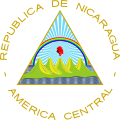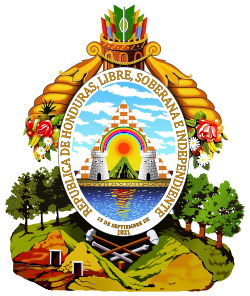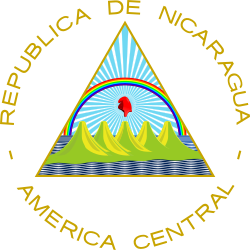Vulkanwappen
Unter Vulkanwappen sind die Wappen der Staaten von Mittelamerika zu verstehen, die zwischen den Jahren 1823 und 1838/39 den Staatenbund der Vereinigten Provinzen von Mittelamerika bildeten. Dazu gehörten die Staaten Costa Rica, Honduras, Nicaragua, El Salvador und Guatemala. Sie zeigten und zeigen in ihren Wappen als Wappenfigur Vulkane. Guatemala hat seit 1871 ein geändertes Wappen.
Galerie
Wappen Guatemalas von 1825
Siehe auch
Literatur
- Gert Oswald: Lexikon der Heraldik. VEB Bibliographisches Institut, Leipzig 1984, ISBN 3-411-02149-7, S. 411.
Weblinks
Auf dieser Seite verwendete Medien
The coat of arms of Honduras was created on October 3, 1825. Dionisio Herrera, as the Head of State of Honduras, decreed through his initiative, Honduras acquired its own national shield, one which represents Honduran history and the rich variety of national resources that it possesses and which should be protected and conserved. The National Congress thereby declared in its decree #16 and article 142, designated the shield as a national symbol for all uses, in a clear and general manner. The National Congress approved this in Tegucigalpa on January 10, 1935. (http://www.honduras.com/official/)
The National Congress decrees:
Article 1 - The National Coat of Arms that shall be used is an equilateral triangle. On its base is a volcano between two castles, over them is a rainbow and below it [and] behind the volcano a sun rises spreading light. The triangle [is] placed over land which appears to be bathed by both seas [Atlantic and Pacific]. Around it an oval containing in gold lettering: "REPUBLICA DE HONDURAS, LIBRE, SOBERANA E INDEPENDIENTE. 15 DE SEPTIEMBRE DE 1821" [Republic of Honduras, Free, Sovereign and Independent. 15th September 1821] On the top part of the oval there is a quiver full of arrows from which hang horns of plenty joined with a knot resting over a mountain range from which clearly stand three oak trees on the right hand side and three pine trees on the left, and mines, a bar, a drill, a wedge, a sledgehammer and a hammer [all] distributed as appropriate. (http://flagspot.net/flags/hn).html)Autor/Urheber: Anjelkaido, Rastrojo, HansenBCN, Lizenz: CC-BY-SA-3.0
Escudo de las Provincias del Centro de América: "El escudo de armas de las Provincias Unidas será un triángulo equilátero. En su base aparecerá la cordillera de cinco volcanes colocados sobre un terreno que se figure bañado por ambos mares: en la parte superior un arco iris que los cubra; y bajo el arco el gorro de la libertad esparciendo luces. En torno del triángulo y en figura circular, se escribirá con letras de oro: Provincias Unidas del Centro de América [...] El pabellón nacional constará de tres fajas horizontales, azules la superior y la inferior y blanca la del centro, en la cual irá dibujado el escudo..." Fuente
Ejemplares:
Especificaciones:
- Algunos ejemplares muestran los volcanes sombreados para ilustrar volumen. El terreno que soporta los volcanes se inscribe en el triángulo, mientras que ambos mares quedan al exterior.
- Sobre el mar, un cielo azul celeste.
- El arco iris se muestra con los 7 colores más comunes al representarlo.
- El gorro de la libertad o gorro frigio se sostiene sobre un bastón, habitual en algunas de las banderas derivadas. El efecto de esparcimiento de luz se muestra como en el tercer ejemplar.
- En el inferior de la cinta con la inscripción aparece una estrella no descrita, que aparece de 5 o 6 puntas en borde o relleno azul o dorado. Se ha optado por 6 (por ser 6 las provincias la mayor parte del tiempo) y dorado como las letras.
- Alrededor de la inscripción, círculos concéntricos azules como en el tercer ejemplar.
Arms of Guatemala 1825
Coat of arms of El Salvador
- The coat of arms has the words (REPÚBLICA DE EL SALVADOR EN LA AMÉRICA CENTRAL) in a bold and Heavy, Sans Serif Boris Black Bloxx typeface, in a golden amber color
- The nacional motto (DIOS UNIÓN LIBERTAD) in bold version of Trajan (typeface), Roman type, Roman square capitals. The letters are colored black within a golden amber scroll.
- The date (15 DE SEPTIEMBRE DE 1821) in bold version of Trajan (typeface), Roman type, Roman square capitals.











